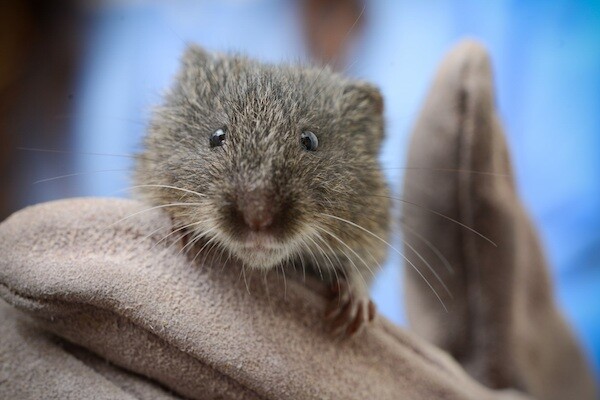Breeding Program May Save Desert Rodent

An adorable desert rodent once thought extinct is suffering from the state's extended drought, but a university's captive breeding program may just keep the critter around a while longer.
Once found in wetlands along a 20-mile stretch of the Amargosa River near Death Valley from Shoshone to the Amargosa Canyon, the Amargosa vole, Microtus californicus scirpensis, is now limited to a few small populations near Tecopa. Those populations are so small the vole was actually thought extinct in the 1970s. The voles' preferred habitat, open water vegetated by bulrush, is in very short supply in the California desert even in the best of years, and populations tend to die back as marshes along the Amargosa River dry up in summer.
In this drought year, the largest marsh hosting Amargosa voles started drying up earlier than usual, and biologists monitoring the subspecies feared that this summer's population decline might be steeper than usual. That's a problem: it's been estimated that the Amargosa vole is at risk of actual extinction in the next five years. The biologists' response: capture voles and allow them to breed in a protected setting at the University of California Davis School of Veterinary Medicine. And that move seems to be paying off, with three of the ten breeding pairs producing four healthy baby voles.
The other seven pairs are being prepped for breeding, a long process that involves genetic testing to prevent inbreeding and screening for disease.
"We know the population is already inbred, but we don't know whether that has affected them as a species," said project lead Janet Foley, a professor of veterinary medicine and epidemiology at UC Davis. "There's so much we have yet to learn about this subspecies. This is a great opportunity to understand population genetics, basic ecology and behavior. Previously, we've made assumptions about those things, but now we can verify them."
The captive breeding program is being conducted in cooperation with researchers from UC Berkeley, the California Department of Fish and Wildlife, the Bureau of Land Management, the U.S. Fish and Wildlife Service, the U.S. Geological Survey, and UC Berkeley.
Though four baby voles may not seem like a huge population increase, the success of breeding new voles at all is a significant step for the subspecies. After being rediscovered in the late 1970s, the Amargosa vole -- one of 17 subspecies of the more widespread California vole -- was listed as Endangered under the California Endangered Species Act in 1980, with federal listing as Endangered following in 1984. The most recent population sampling cited in USFWS's 2009 review of the subspecies turned up fewer than 100 individual voles in 1998. With numbers that low, even a handful of new babies can make a difference.
Once the breeding program produces several hundred adults, Foley and her colleagues plan to release them into suitable habitat along the Amargosa River. That won't solve the voles' problem in the long term, as that habitat is under threat. Not only do factors like drought, climate change and predation pressure from outdoor cats in Tecopa pose a threat to the Amargosa vole, but the exotic tamarisk trees that line much of the Amargosa can swiftly invade the voles' bulrush marshes if not kept under control.
But the captive breeding program will at least give the voles a fighting chance to survive the next few years as land managers work to protect their habitat.


